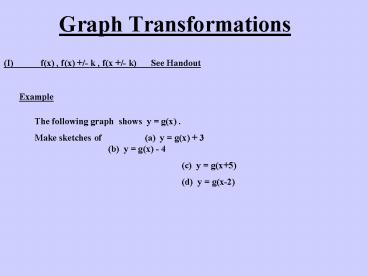Graph Transformations - PowerPoint PPT Presentation
1 / 19
Title:
Graph Transformations
Description:
Graph Transformations (I) f(x) , f(x) +/- k ... (4,2) (1,-1) (12,2) (4,2) (3,-1) (1,-1) Trig Graphs The same transformation rules apply to the basic trig graphs ... – PowerPoint PPT presentation
Number of Views:148
Avg rating:3.0/5.0
Title: Graph Transformations
1
Graph Transformations
(I) f(x) , f(x) /- k , f(x /- k) See Handout
Example
The following graph shows y g(x) . Make
sketches of (a) y g(x) 3 (b) y
g(x) - 4 (c) y g(x5) (d) y g(x-2)
2
y g(x)
(31, 7)
(23, 2)
X
Key points are (23,2) and (31,7).
To transform the graph transform the points.
3
For y g(x) 3 move everything 3 units up.
(23,2) ? (23,5)
(31,7) ? (31,10)
y g(x) 3
(31, 10)
(23, 5)
X
4
For y g(x) - 4 move everything 4 units
down.
(23,2) ? (23,-2)
(31,7) ? (31,3)
y g(x) - 4
(31, 3)
X
(23, -2)
5
For y g(x5) move everything 5 units left.
(23,2) ? (18,2)
(31,7) ? (26,7)
y g(x5)
(26, 7)
(18, 2)
X
6
For y g(x-2) move everything 2 units right.
(23,2) ? (25,2)
(31,7) ? (33,7)
y g(x-2)
(33, 7)
(25, 2)
X
7
NB (I) /- changes outside the brackets slide
the graph in the Y direction in the way
you would expect. ie goes
up - goes down.
(II) /- changes inside the brackets slide the
graph in the X direction in the
opposite way to which you would expect.
ie goes back - goes forward .
8
Example
The graph below shows y f(x)
Make sketches of (I) y -f(x)
(II) y f(-x)
y f(x)
(14,6)
(17,5)
X
12
Main points are (12,0), (14,6) (17,5).
9
For y -f(x) we reflect in the X-axis.
(12,0)?(12,0)
(14,6)?(14,-6)
(17,5)?(17,-5)
X
12
(17,-5)
(14,-6)
y -f(x)
NB max TP now min TP min TP now max TP.
10
For y f(-x) we reflect in the Y-axis.
(12,0)?(-12,0)
(14,6)?(-14,6)
(17,5)?(-17,5)
y f(-x)
(-14,6)
(-17,5)
X
-12
11
Example
Here is the graph of y f(x)
Make sketches of (I) y 4 f(x) (II) y
f(3x)
y f(x)
(12,2)
X
(3,-1)
Main points are (12,2) (3,-1).
12
(I) To obtain y 4 f(x) we stretch the
graph vertically by a factor of 4 (ie mult
y-coords by 4).
(12,2)?(12,8)
(3,-1)?(3,-4)
y 4f(x)
(12,8)
X
(3,-4)
13
(II) To obtain y f(3x) we squash the
graph horizontally by a factor of 3 (ie divide
x-coords by 3).
(12,2)?(4,2)
(3,-1)?(1,-1)
y f(3x)
(4,2)
X
(1,-1)
14
Trig Graphs
The same transformation rules apply to the basic
trig graphs.
NB If f(x) sinx? then 3f(x) 3sinx?
and f(5x) sin5x?
Think about sin replacing f !
Also if g(x) cosx? then g(x) 4 cosx ?
4 and g(x90) cos(x90) ?
Think about cos replacing g !
15
Example
Sketch the graph of y sinx? - 2 !
If sinx? f(x) then sinx? - 2 f(x) -
2
So move the sinx? graph 2 units down.
y sinx? - 2
16
Example
Sketch the graph of y cos(x - 50)? !
If cosx? f(x) then cos(x - 50)? f(x
- 50)
So move the cosx? graph 50 units right.
y cos(x - 50)?
17
Example
Sketch the graph of y 3sinx? !
If sinx? f(x) then 3sinx? 3f(x)
So stretch the sinx? graph 3X vertically.
y 3sinx?
18
Example
Sketch the graph of y cos4x? !
If cosx? f(x) then cos4x? f(4x)
So squash the cosx? graph to 1/4 size
horizontally.
y cos4x?
19
Example
Sketch the graph of y 2sin3x? !
If sinx? f(x) then 2sin3x? 2f(3x)
So squash the sinx? graph to 1/3 size
horizontally and also double its height.
y 2sin3x?































